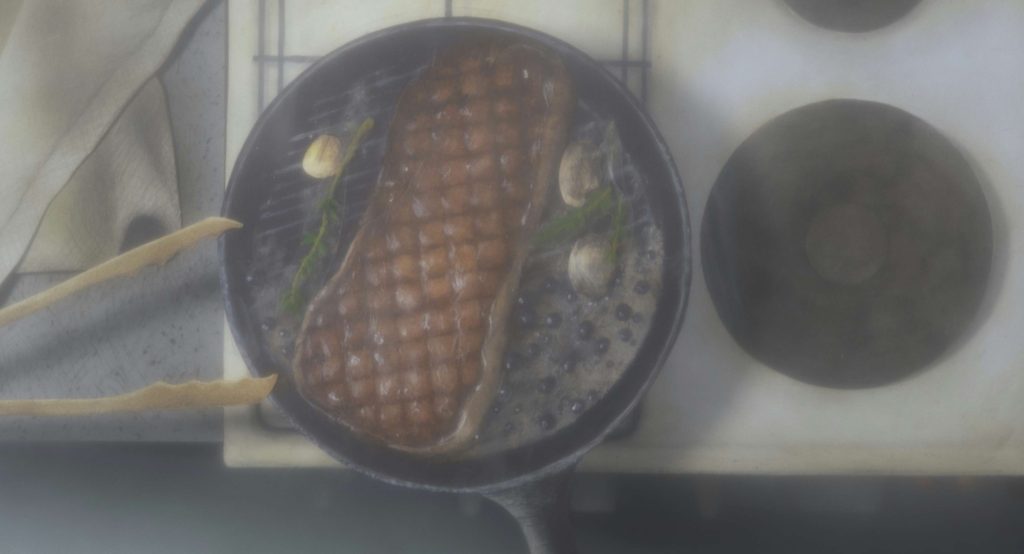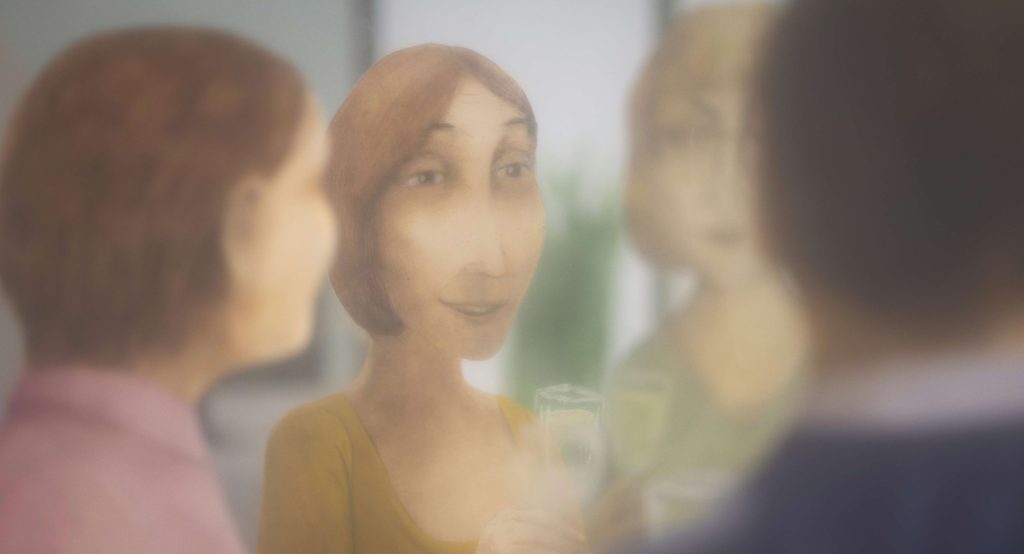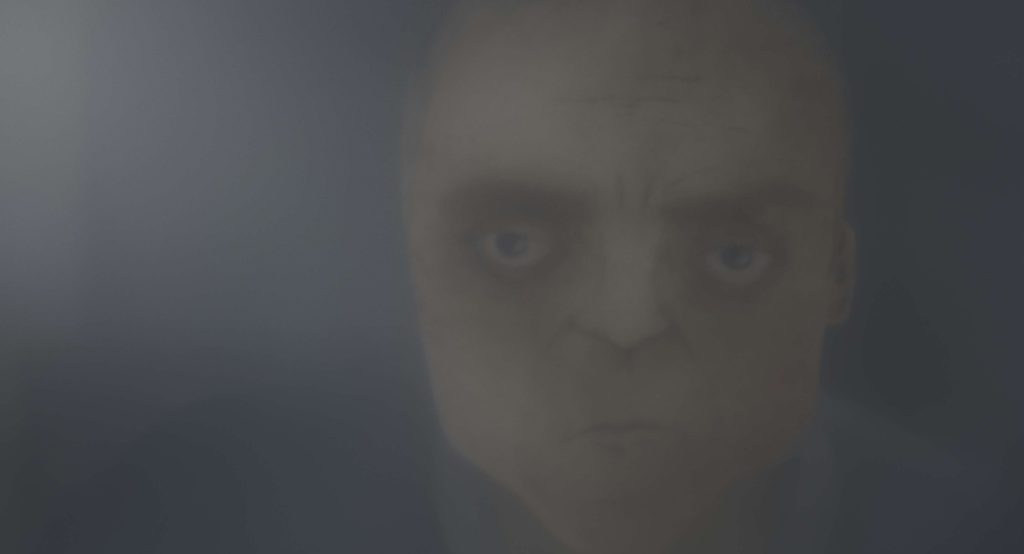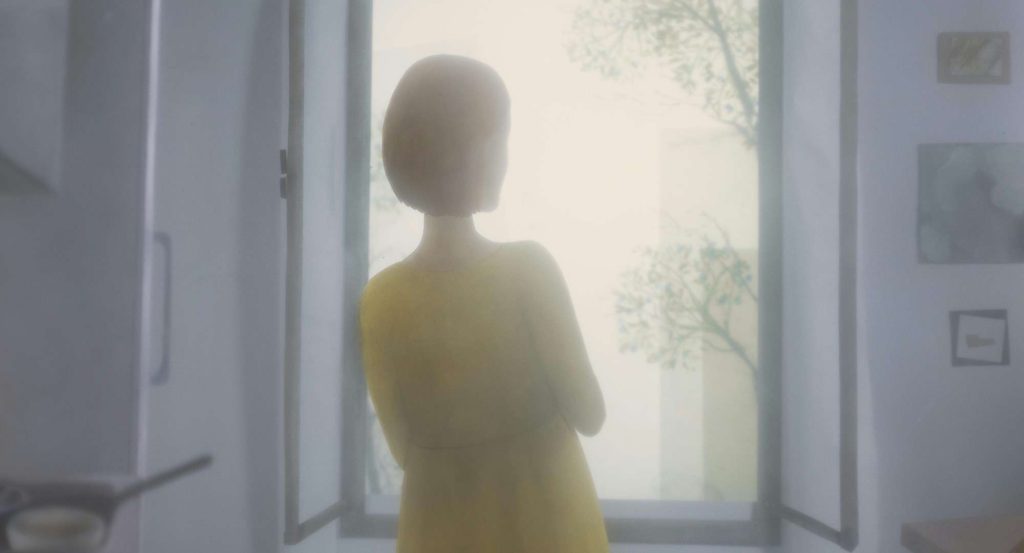Interview with Špela Čadež: “You challenge yourself by trying something for weeks, and then it suddenly opens up”
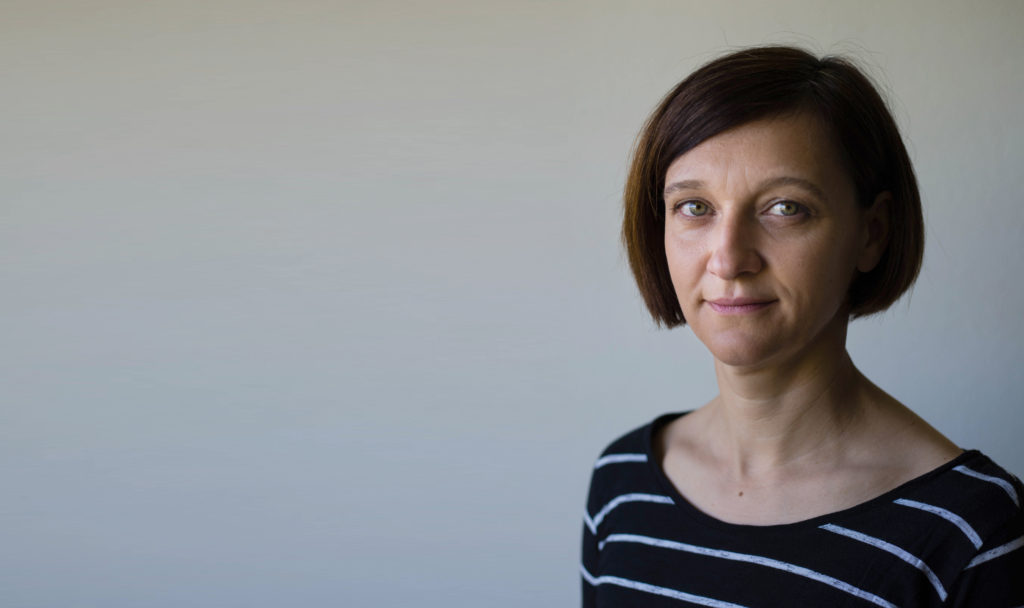
Špela Čadež’ eight short animation Steakhouse is a powerful take on the domestic, psychological abuse packed in just 9′ 30” of runtime. Created with the use of multiplane camera set up to achieve motion in animation with the help of oil-painted cell and paper cut-outs, Steakhouse almost feels as a live-action despite of its clear visual background.
Making a film about something that is difficult to describe and turning it into a universal story of toxic relationships in which one person turns a domestic life into hell requires more than just the directorial talent. What starts as a simple story of a man preparing meal for his wife’s birthday, transforms into a heavy display of passive agression.
We spoke to Špela Čadež few days before the film’s premiere in Locarno, where it screened in the competition of Pardi di Domani. From there, Steakhouse went straight to the short film competition of Sarajevo, and it will most certainly continue to conquer the audiences internationally.
This is the only second time that you are using the multiplane technique. “Nighthawk” marked the beginning. Can you tell us something about your decision to use multiplane, and how it developed over time since your first experience with it?
I don’t really think about revolutionizing anything. I would say that I am just trying to create the best environment to tell a story. I am not trying to crack Yuriy Norshteyn, I just love this technique because it gives me a lot of space for experimenting. I think that there is still so much to discover. There is this sort of strange thing with painted images because they are at the different distance from the cameras with the depth making them look realistic although they obviously are not. This is what is tempting in using the multiplane technique, because you can play with realism that goes into a dream world, and it feels like it’s a painted realism. It’s still very much to discover for me, we are still exploring the possibilities, which is something I love. You challenge yourself by trying something for weeks, and then it suddenly opens up.
“Steakhouse” deals with a very sensitive topic of verbal domestic violence invisible for anyone outside of the household because it doesn’t leave bruises.
It is a very important subject to talk about. Even if we started making the film before all these lockdowns, the topic has become more important to address over the past year and a half. When you see physical violence happening next door, you can act and call the police, but when you hear the psychological violence – or you don’t, because silence can be even more threatening – you can’t do anything about it, although the victims can be even more brutaly harmed. That’s why we should talk about it and speak up for the victims. I haven’t shown this film to many people because its premiere is about to happen here in Locarno in two days, but those who did could see something in it that was torturing them in some way. They identified something or somebody from their own lives. Most of us have the experience of being verbaly abused.
The way the story is built is just the way it happens in real life – you don’t notice what’s happening until a certain point when the heavy smoke spreads in the apartment.
It was again one element that was more important than the characters in that moment. The smoke from overcooked steak becomes the main character which takes over the atmosphere. I have to say that it was challenging to decide how long we should leave them in the completely smoked room, but afterwards, when we started animating the scene, I realized that that was the best part of the film because it didn’t require any explanations before or after. It had a clear symbolism. Everything was already in it.
The film is also stepping in the domain of genre.
It wasn’t meant to be genresque, what happened at the end is more of a metaphor. I was very afraid how this ending would turn out because it could have had a completely different effect. It sounded very brutal in the script, as it wasn’t quite clear why she would react that way. But due to the heavy smoke it becomes clear that everything happening that afternoon marked the edge of a relationship when it breaks. I wasn’t actually thinking about how people would interprete that final scene. My mind is always on the subject. I was challeneged to talk about domestic, psychological violence, and to show it.
Let’s talk about the music in your film, and about your collaboration with the experimental band Olfamož.
Actually, this was not planned in advance. Only during the sound design – when Franz is preparing the steak – we realized that there should be something like him listening to the radio, so we tried to find the right beat. At the end we decided that he might as well listen to a record, which would make us focus more on his character. I already chose some music, but my composer Tomaž Grom intervened and said that that particular beat wasn’t working in my film, and that I needed something artistic. That’s when he suggested Olfamož, which is a Slovenian improvisational band collective composed by and around the multi-instrumentalist Andrej Fon.
I think that Tomaž edited the music so well to the point that it completely supports the narrative. It starts soft and developes into an aggresive sound. He did an excellent job with it. That’s the music that I never thought would fit because I was into something completely different.
How do you work with your team of animators?
I was lucky to had two artists working with me. One is Zarja Menart who already animated “Nighthawk”, and who was the main animator. She is actually making her first film now, and I am thrilled for her. Also, I had for the first time Anka Kočevar who’s the painter and illustrator, and she was amazing in drawing all those realistic hands. She did a lot of drawing, so we were mostly preparing work. And then, there was a French animator Clémentine Robach who did the bits of animation on computer. We printed them out and coloured them, and there was a lot of work with hands involved. We had a super nice atmosphere in the studio, and we were looking forward to each day working together. The studio was filled with joy and laughter, so all the work felt so easy. I have to say, it was a great team.
We painted each frame not only in one layer, but sometimes in two or three. It was a lot of work, but all other things made it fun as well. I love doing analogue films because I work with my hands and paint.
It is a very long process, so how long did it take you to make the film?
It was about a year and a half. In live action you have to do everything in just a couple of days, but here you are running a marathon, so achieving that the team feels well, and that the studio has a nice atmosphere is a really important part of the process. We were sad when we approached the end.
How does it feel like competing in Locarno?
A bit scary. I’ve been to Sundance, and to other big festivals, but I’ve never been here before. I think that I never had expectations about giant festivals, that’s why I am happy to be a part of it. As far as I can see, Locarno is focusing more on shorts now which is great, because I think that short format is wonderful.
The most important thing for me now is to experience the film with the audience. I know that it’s going to be precious because we were going through lockdown after lockdown. When I make a film, I really love to have the experience sitting in the audience and seeing the reactions. You can hear them breathe differently and then I know that it was worth it drawing and painting. I am travelling there tomorrow, and I am really looking forward to it. I was send going on the on-line tour, because films need to be seen in the cinema. Maybe some films work the same both on small and big screen, but still, the feeling is different.

